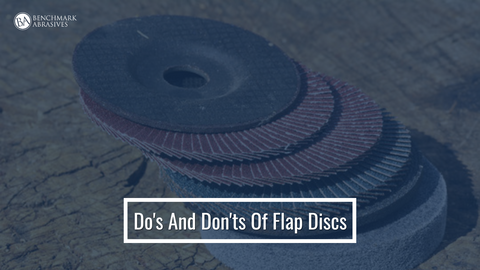
Do's And Don'ts Of Flap Discs

The metal manufacturing and finishing sectors are seeing an increase in the use of coated abrasive flap discs. Portable electric and pneumatic angle grinders, goods are frequently utilized in place of grinding wheels and coated abrasive discs. Due to its rising popularity, it is wise to brush up on flap disc safety while concentrating on the three potential trouble spots.
AN ADEQUATE GRINDING ANGLE AND SURFACE
It's crucial to utilize flap discs on the proper surface and at the proper angle. Epoxy wear, backing disc damage, and snagging can all result from using the wrong angle or surface. Any of these may cause the flaps to separate or the backing disc to break. Both Type 27 and Type 29 flap discs should be utilized at an angle of 0° to 15° and 15° to 25°, respectively, to the workpiece. Use neither flat nor on an edge.
GUARDS
The use of coated abrasive materials gives rise to the misperception that protections are not necessary. Simply said, this is untrue.
According to the extremely plain language of ANSI B7.7, "If the machine is designed and equipped with guards, it shall not be operated without the guards properly installed and in place." Angle grinders with guards are intended to be used with flap discs.
Additionally, the 2017 update to ANSI B7.1 Safety Conditions for Using, Caring for, and Protecting Abrasive Wheels Specifies specifications in detail for flap disc wheels: "All limitations of mounting and use listed for Type 27 wheels shall apply to Type 27 and Type 29 abrasive flap disc wheels."
B7.1 adds, "These wheels are recommended for use only on specially designed and guarded machines." Make sure your grinder is set up between you and the disc, has the right guard, and is in good shape. The guard is intended to confine the pieces and safeguard you in the event of a breaking or flap separation. Never operate a grinder unguarded!
INSPECTION/HANDLING
Before using, check the flap discs for any signs of damage. A disc that has been dropped or handled improperly may sustain damage that eventually results in breakage. A damaged or fallen disc should not be used.
ADDITIONAL DO'S AND DON'TS
To ensure that your quality flap discs are used correctly and safely, it's crucial to adhere to the fundamental do's and don'ts for flap discs in addition to these three areas.
DO'S
- Do keep abrasive flap discs at the specified 60–80° F (15–29° C) and 40–50% relative humidity. Maintain them in their original containers and keep them away from liquids like water.
- Do Revolve the stock. First in, first out is the way to use flap discs.
- Do follow all safety instructions included with the flap discs, equipment, and tools, as well as ANSI B7.7, OSHA, and any safety documentation.
- Never leave the tool connected to power when changing a flap disc.
- A 7" flap disc should be used with a 7" grinder or sander, for example.
- Do compare the machine's speed to the safe operating speed indicated on the flap disc. Never go faster than a flap disc's rated speed.
- Do put on appropriate personal protection, such as impact-resistant eye and facial protection that has received ANSI approval, arm guards, an apron, gloves, safety shoes, etc. Where dangerous elements, such as wood dust, toxic metal particles, etc., may be formed during operation, the use of a respirator is needed.
- Before using your flap disc, run it at working speed for one full minute in a contained space, such as a barrel.
- When your angle grinder or sander comes with a side handle, use it.
- Before using this product, please read all applicable SDS (Safety Data Sheets). The SDS finder can be used to locate Norton flap disc safety data sheets.
- If you have safety concerns, do not hesitate to contact your abrasive manufacturer.
DON'TS
- Avoid using inappropriate tools, such as pistol-grip air sanders.
- Avoid keeping abrasive flap discs near heat sources like radiators or steam pipes, near open windows, in full sunlight, or on concrete floors.
- Avoid wearing loose clothing, jewelry, or anything else that can snag on moving parts of the apparatus.
- Limit your RPM to the number shown on the flap disc.
- On a machine that isn't in good functioning order, avoid installing a flap disc.
- Avoid pressing the flap disc against a workpiece.
- Don't cause a danger. Protect anyone standing nearby from the spark/debris stream (shower) and any flammable materials.
- Avoid letting the material you are abrading "load up" on the flap disc.
- If you haven't read through all the safety information and haven't received the necessary training to use the tool and flap disc, don't use a flap disc.



































































